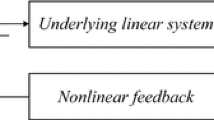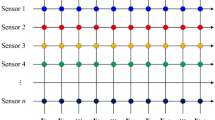Abstract
Purpose
Nonlinear system identification heavily relies on the accuracy of nonlinear unit model selection. To improve identification accuracy, the Sparse Bayesian Learning method is incorporated into the nonlinear subspace. Enhanced nonlinear subspace identification is proposed.
Methods
The nonlinear term in the system is treated as an internal excitation. By applying low-level excitation, the response of the structure can be approximated as linear, allowing for the determination of the linear frequency response function of the structure. High-level excitation is then applied to separate the response caused by intrinsic nonlinear force excitation. The type of nonlinearity is evaluated using Spike-and-Slab Priors for Sparse Bayesian Learning. Finally, the screened nonlinear elements are substituted into subspace identification to determine nonlinear parameters.
Results
The effectiveness of this method in dealing with nonlinear stiffness and dam** is verified through a simulation example and its robustness is further discussed. Experiments on negative stiffness systems also demonstrate the method's good applicability when dealing with complex dam**.
Conclusion
Incorporating the Sparse Bayesian Learning method into the nonlinear subspace significantly improves the accuracy of nonlinear system identification. The proposed approach effectively deals with nonlinear stiffness and dam**, as validated by simulation results. The method's robustness is further demonstrated through extensive discussions, while experiments on negative stiffness systems showcase its applicability in complex dam** scenarios.















Similar content being viewed by others
Data availability
Data will be made available on request.
References
Marchesiello S, Garibaldi L (2008) Identification of clearance-type nonlinearities. Mech Syst Signal Process 22(5):1133–1145. https://doi.org/10.1016/j.ymssp.2007.11.004
Nelles O (2020) Nonlinear system identification: from classical approaches to neural networks, fuzzy models, and gaussian processes. Springer Nature, Cham
Stender M, Oberst S, Hoffmann N (2019) Recovery of differential equations from impulse response time series data for model identification and feature extraction. Vibration 2(1):25–46
Chen D, Gu C, Fang K et al (2021) Vortex-induced vibration of a cylinder with nonlinear energy sink (NES) at low Reynolds number. Nonlinear Dyn 104(3):1937–1954
Kerschen G, Worden K, Vakakis AF, Golinval J (2006) Past, present and future of nonlinear system identification in structural dynamics. Mech Syst Signal Process 20:505–592. https://doi.org/10.1016/j.ymssp.2005.04.008
Noël JP, Kerschen G (2017) Nonlinear system identification in structural dynamics: 10 more years of progress. Mech Syst Signal Process 83:2–35. https://doi.org/10.1016/j.ymssp.2016.07.020
Zhu R, Jiang D, Marchesiello S et al (2023) Automatic nonlinear subspace identification using clustering judgment based on similarity filtering. AIAA J. https://doi.org/10.2514/1.J062816
Hot A, Kerschen G, Foltête E et al (2012) Detection and quantification of non-linear structural behavior using principal component analysis. Mech Syst Signal Process 26:104–116
Sun W, Paiva ARC, Xu P et al (2020) Fault detection and identification using Bayesian recurrent neural networks. Comput Chem Eng 141:106991
Peng ZK, Lang ZQ (2007) Detecting the position of non-linear component in periodic structures from the system responses to dual sinusoidal excitations. Int J Non-Linear Mech 42(9):1074–1083
** M, Kosova G, Cenedese M et al (2022) Measurement and identification of the nonlinear dynamics of a jointed structure using full-field data; part II-nonlinear system identification. Mech Syst Signal Process 166:108402
Ji Y, Zhang C, Kang Z et al (2020) Parameter estimation for block-oriented nonlinear systems using the key term separation. Int J Robust Nonlinear Control 30(9):3727–3752
Marchesiello S, Garibaldi L (2008) A time domain approach for identifying nonlinear vibrating structures by subspace methods. Mech Syst Signal Process 22:81–101. https://doi.org/10.1016/j.ymssp.2007.04.002
Anastasio D, Fasana A, Garibaldi L, Marchesiello S (2020) Nonlinear dynamics of a duffing-like negative stiffness oscillator: modeling and experimental characterization. Shock Vib. https://doi.org/10.1155/2020/3593018
Zhu R, Fei Q, Jiang D et al (2021) Identification of nonlinear stiffness and dam** parameters using a hybrid approach. AIAA J 59(11):4686–4695
Al-Hadid MA, Wright JR (1989) Developments in the force-state map** technique for non-linear systems and the extension to the location of non-linear elements in a lumped-parameter system. Mech Syst Signal Process 3(3):269–290
Simoen E, Papadimitriou C, Lombaert G (2013) On prediction error correlation in Bayesian model updating. J Sound Vib 332(18):4136–4152
Nayek R, Fuentes R, Worden K et al (2021) On spike-and-slab priors for Bayesian equation discovery of nonlinear dynamical systems via sparse linear regression. Mech Syst Signal Process 161:107986
Koch B, Vock DM, Wolfson J et al (2020) Variable selection and estimation in causal inference using Bayesian spike and slab priors. Stat Methods Med Res 29(9):2445–2469
Zhu R, Fei Q, Jiang D et al (2019) Removing mass loading effects of multi-transducers using Sherman-Morrison-Woodbury formula in modal test. Aerosp Sci Technol 93:105241
Folland GB (2009) Fourier analysis and its applications. American Mathematical Soc, New York
Dempsey KM, Irvine HM (1978) A note on the numerical evaluation of Duhamel’s integral. Earthquake Eng Struct Dynam 6(5):511–515
Huang Y, Beck JL, Li H (2017) Bayesian system identification based on hierarchical sparse Bayesian learning and Gibbs sampling with application to structural damage assessment. Comput Methods Appl Mech Eng 318:382–411
Zhu R, Fei Q, Jiang D et al (2022) Bayesian model selection in nonlinear subspace identification. AIAA J 60(1):92–101
Zhu R, Marchesiello S, Anastasio D et al (2022) Nonlinear system identification of a double-well Duffing oscillator with position-dependent friction. Nonlinear Dyn. https://doi.org/10.1007/s11071-022-07346-1
Liu Q, Zhang Y, Hou Z et al (2023) Optimal Hilbert transform parameter identification of bistable structures. Nonlinear Dyn 111(6):5449–5468
Acknowledgements
The research results were supported by the General Project of Natural Science Research in Jiangsu Universities (No. 20KJB410001) and the National Science Research Program Cultivation Fund (No.2022NCF004 & 2022NCF005) of Southeast University Chengxian College.
Author information
Authors and Affiliations
Corresponding author
Ethics declarations
Conflict of Interest
The authors declare that they have no conflict of interest concerning the publication of this manuscript.
Additional information
Publisher's Note
Springer Nature remains neutral with regard to jurisdictional claims in published maps and institutional affiliations.
Rights and permissions
Springer Nature or its licensor (e.g. a society or other partner) holds exclusive rights to this article under a publishing agreement with the author(s) or other rightsholder(s); author self-archiving of the accepted manuscript version of this article is solely governed by the terms of such publishing agreement and applicable law.
About this article
Cite this article
Zhu, R., Chen, S., Jiang, D. et al. Enhancing Nonlinear Subspace Identification Using Sparse Bayesian Learning with Spike and Slab Priors. J. Vib. Eng. Technol. 12, 3021–3031 (2024). https://doi.org/10.1007/s42417-023-01030-3
Received:
Revised:
Accepted:
Published:
Issue Date:
DOI: https://doi.org/10.1007/s42417-023-01030-3




